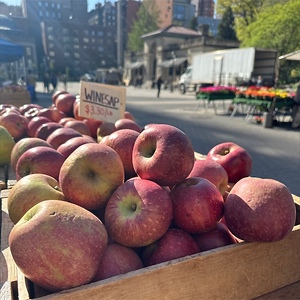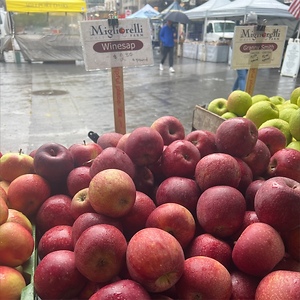


Winesap Apples
Estimated Inventory, lb : 0
This item was last sold on : 10/20/24
Description/Taste
Winesap apples are a small to medium-sized varietal and have a round to oblong, somewhat uniform shape with flat shoulders and curved edges. The apples bear glossy, thick skin, creating a semi-tough and chewy texture. The surface also showcases some ribbing, tan lenticels, and a yellow-green base, almost entirely covered in a bright to dark red blush with crimson striping. Underneath the surface, the yellow flesh is aqueous, coarse, and dense with a crisp and crunchy consistency. The flesh also encases a small central core filled with tiny, black-brown seeds. Winesap apples have a sweet, fruity, and spice-like aroma and a balanced, sweet-tart flavor with tangy, sweet, and subtly savory wine-like nuances. The variety also produces pink blossoms in the spring, distinct from other apple trees that usually bear white flowers.
Seasons/Availability
Winesap apples are available in the late fall through winter.
Current Facts
Winesap apples, botanically classified as Malus domestica, are an American heirloom variety belonging to the Rosaceae family. Since colonial times, the late-season apple has been cultivated in gardens and was highly favored for its distinct flavor, color, and juicy nature. Winesap apples are an all-purpose variety frequently incorporated into fresh and cooked preparations throughout the 19th and 20th centuries. The apples were also utilized among cideries as a base flavoring and provided a complex, tart, and subtly sweet taste. Winesap apples earned their name from their signature wine and spice-like flavor, and the variety was sometimes known as Wine-sop or American Wine-sop. While Winesap apples were commercially popular in the early 20th century, the variety has been largely overshadowed by cultivars such as red delicious in the modern day. Winesap apples have also been used in breeding, and several descendants have also taken the place of their parent apple in orchards, including stayman winesap and Arkansas black.
Nutritional Value
Winesap apples are a source of vitamins, including vitamin C to strengthen the immune system, vitamin A to maintain healthy organ functioning, vitamin E to protect the cells against free radical damage, and vitamin K to assist in faster wound healing. The apples also provide fiber to regulate the digestive tract, potassium to balance fluid levels within the body, calcium to build strong bones and teeth, and lower amounts of boron, iron, phosphorus, magnesium, copper, and zinc.
Applications
Winesap apples have a sweet, tart, and subtly savory flavor well suited for an array of fresh and cooked preparations. The apples can be consumed straight, out of hand, but consumers may choose to peel the skin before eating as the skin can be chewy and sometimes tough. Winesap apples can also be chopped into salads, shredded into slaws, mixed into fruit and grain bowls, layered into sandwiches, or sliced and displayed on appetizer platters with nut butter, cheeses, and other fruit. In addition to fresh preparations, Winesap apples have firm flesh and hold their shape well, allowing the fruits to be utilized in cooked preparations such as sauces, jelly, jam, and butter. Winesap apples can also be baked into bread, muffins, turnover, pies, crisps, and crumbles, or they can be sauteed, baked, or fried as a healthy dessert. Try dicing the apples and adding them to stuffing for roasted meats or squashes. Beyond culinary dishes, Winesap apples are notable for their use in ciders and can be pressed into juice. Winesap apples pair well with cheeses such as cheddar, brie, goat, and manchego, nuts such as pecans, walnuts, and almonds, herbs including sage, rosemary, mint, and parsley, vanilla, caramel, and spices such as cinnamon, ginger, cloves, and nutmeg. Whole, unwashed Winesap apples will last for at least three months when kept in professional cold storage.
Ethnic/Cultural Info
Winesap apples are most famously used in modern-day cider blends, especially among cideries in Virginia. The heirloom variety is one of thirty apple cultivars grown in Virginia for ciders, and the entire apple is ground into a pulp, also known as pomace, and the juice is fermented to make the savory-sweet beverage. Cider has historically been a popular fermented beverage in America, as the fermented drink could last for long periods of time without the need for refrigeration. In colonial times, cider was consumed as a table drink and was drunk more consistently than water among both adults and children. Cider was also considered safer to drink than water as the fermentation removed bacteria like e-coli, and unfiltered cider provided vitamin C to protect sailors against scurvy. In the present day, ciders are still traditionally made among craft cideries in Virginia, and there is an annual cider week celebrated in the late fall. During cider week, the Virginia cider industry is recognized through cider pairing dinners, cider tours, tastings, and educational workshops.
Geography/History
Winesap apples are a heritage variety that was first recorded in 1804 by Dr. James Mease. The record mentioned that the variety was cultivated in Moore’s Town, New Jersey, by Samuel Coles and was a popular cider apple. The exact origin and history of the variety are mostly unknown, with experts believing the apples date back to at least colonial times. Winesap apples were later introduced into the Southern United States, especially in Virginia, where they were extensively cultivated up until the 1950s. In the late 20th century, Winesap apples faded from commercial production due to advancements in refrigeration, allowing an influx of other apple varieties to permeate the market. Today Winesap apples are grown as a specialty variety in the Pacific Northwest, Virginia, Georgia, and other regions along with the Eastern United States. Winesap apples are also grown in England, Turkey, France, and Italy.
Recipe Ideas
Recipes that include Winesap Apples. One

















